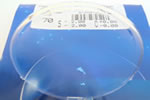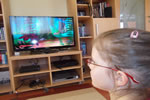Prescription consistency
by Tom R
(Boston)
Q: In looking into ordering new reading glasses I decided to look back at old prescriptions. Here is the record I found:
11/20/99: OD +0.00 Cyl 0 Axis 0 / OS +0.00 Cyl 0 Axis 0 / Add 1.25
01/15/02: OD +0.00 Cyl 0 Axis 0 / OS +0.25 Cyl -0.50 Axis 65 / Add 1.75
09/30/03: OD +0.00 Cyl 0 Axis 0 / OS +0.25 Cyl -0.50 Axis 65 / Add 2.00
01/29/09: OD +1.00 Cyl +0.50 Axis 110 / OS +1.00 Cyl -0.50 Axis 65 / Add 2.00
02/09/12: OD +1.25 Cyl -0.50 Axis 120 / OS +0.50 Cyl -0.50 Axis 60 / Add 2.00
08/14/14: OD +1.25 Cyl 0 Axis 0 / OS +1.25 Cyl -0.50 Axis 65 / Add 2.25
09/15/15: OD +1.00 Cyl 0 Axis 0 / OS +1.00 Cyl -1.00 Axis 65 / Add 2.25
08/22/17: OD +1.25 Cyl 0 Axis 0 / OS +1.25 Cyl -0.75 Axis 65 / Add 2.50
(I had to calculate some of these as prescriptions were not all in the same format.)
The variations in the sphere values (recently up and down between 1.00 and 1.25) and left Cyl values, and the 2012 oddity in right astigmatism correction, all made me wonder how reliable these values are.
Are my eyes really changing in the way these measurements say? Or are the measurements just not that precise? Are they too dependent on which of two lenses I say looks better during the exam, when often it is difficult to tell?
Thanks for any feedback ...
A: Hello Tom,
Well, there are some differences between the years you presented here, and let's start with the sphere diopters.
The fact that it got to 1.25 it means you had a hypermetropia that was latent. Over the years, it got harder for your eyes to compensate these diopters so slowly they were integrated into your eyeglasses.
The small differences between 1.00 and 1.25 depending on your state in the moment of consultation. You are tired, your eyes compensate less of your problem, so you feel the need to have stronger diopters.
The reality is that is a subjective test, is based on your answers, so it can have some differences sometimes, but the good news is that these small differences are easy to adapt for you so you shouldn't feel it.
The fact that it got from 0 to 1.25 in a few years, it can mean that you always had this problem, but your eyes could manage it.
When your presbyopia went up, it got harder for your eyes to compensate 2 problems, so you need compensation for that too.
For the cylinder, is pretty much the same thing...., Usually, the cylinder is compensated if is bigger than 1.00 diopter, or if it's smaller but makes your vision better, so maybe you had it all the time, but your optometrist decided not to compensate it because you were ok without it.
Over time, it was added and slowly grown on your prescription.
The second option is that you didn't have it before, and appeared in time, but usually, it does not grow this fast, so if this is the case, I recommend you to have a corneal topography to clarify this.
At the right eye, in 2009 it was -0.50 cylinder ax110, and then in 2012 +0.50 cylinder ax 120, somewhere is a mistake... cannot be both + and - with the almost same axis, it should be a 90-degree difference between them, so... One of them is wrong...
Overall, there are not big differences from year to year, it can be a normal evolution of your hypermetropia and presbyopia, except the mistake there...
I think the most important thing for you is to have a good vision far and close and high comfort wearing your eyeglasses.
For this, I can give you an advice: find a good optometrist or ophthalmologist and stick with him or her, don't change them often, this way you both can check the evolution of your prescriptions from an objective point of view.
Different optometrists have the tendency to write different prescriptions for the same problem. Find the best for you, and visit him or her every year even if you feel is not necessary that often, this way you can keep the problems under control.
Hope this helps,
Arpi
Join in and write your own page! It's easy to do. How? Simply click here to return to FAQ.
Was this information useful?
1. Like Perfect-Eyeglasses-Guide.com on Facebook.
2. Share this article with your friends:




